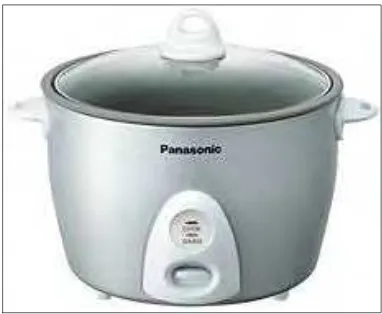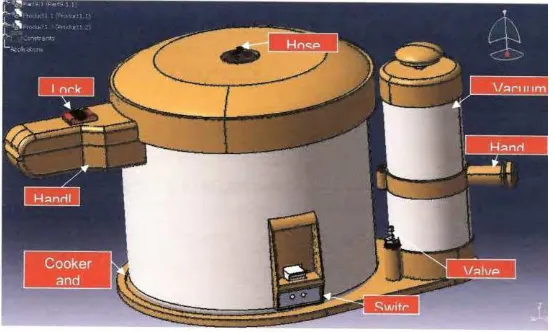i
“I declare that all parts of this report are the result of my own work, except a few sections which were extracted from other resources as being mention”
Student‟s Signature: ...
Name: NURUL SYAZWANI BT. BAKRI
iii
ACKNOWLEDGEMENT
In the beginning, I would like to express my thankful to God for giving the chances to fulfil my Projek Sarjana Muda (PSM) in the title of „The Prototype of Vacuum Cooker For Domestic User‟. My special thanks to Prof. Ir. Mustafar Bin Ab Kadir as my supervisor for my PSM, thank you for accepted me to be one of the student under your and for all the moral support, for guiding me to complete this project and for the concern. Thank you for the ideas, opinion and for the time that have spent for me to complete this PSM. There were a lot of knowledge and experiences I got during this project running. I also want to thanks all the lecturers from Faculty Mechanical Engineering for their guidance given.
ABSTRACT
v
ABSTRAK
TABLE OF CONTENTS
1.6.1 Phase1: Planning Phase 3
1.6.2 Phase 2: Preliminary Phase 3
1.6.3 Phase 3: Analysis Phase 3
1.6.4 Phase 4: Design Phase 3
vii
2.2.2 Performances Measurement 16
2.2.3 Techniques 17
2.2.4 Uses of vacuum pump 21
2.2.5 The types of vacuum pumps that used in industries 22
2.3 An introduction of materials for use in vacuum 25
2.3.1 Selection Criteria 25
2.3.2 Material Properties Requirement 25
2.3.3 Commonly Uses Material 26
2.3.3.1Metal for the Vacuum envelope 26
2.3.4 Metals Used in the Demountable Seals 26
2.3.5 Plastic 27
2.5.1 BOURDON Vacuum Gauge 34
2.5.2 Capsule Vacuum Gauge 34
2.5.3 Diaphragm Vacuum Gauge 35
2.5.4 Capacitance Vacuum Gauge 36
2.5.5 Thermal Conductivity Gauge (Pirani) 36
2.6 Vacuum Flask Cooker
2.8.1 Fruit Crispy Processing 43
2.8.1.1Processing 43
2.8.1.2Specification of Material 44
2.8.1.3Capacity for fruit Process 44
2.9 Choose The Right Vacuum
2.9.1 Ejector is Workhorses 45
ix
3.3 Product Development
3.3.1 Customer Needs 50
3.3.2 Product Specification 50
3.3.3 Conceptual Design 50
3.3.4 Detail Design 50
4.0 Product Development 53
4.1 Types of concept design 54
4.2 The Selection of Vacuum Pump 56
4.3 Vacuum System Use 57
5.4 Prototype of Vacuum Cooker 77
5.5 Discussion
5.5.1 Operational System 80
6.0 Conclusion And Recommendation
6.1 Conclusion 83
6.2 Recommendation 83
LIST OF TABLES
Table 2.0 Universally agreed definitions, but typical distribution 11
Table 2.1 Example pressure of the quality of a vacuum 12
Table4-1 Vacuum or dehydration chart 58
Table 4.1 Vacuum rating and applicable vacuum pumps 59
Table 4.2 Pump capacities and application vacuum pumps 59
Table 4.3 Available of motor-mounted vacuum pumps 60
xi
LIST OF FIGURES
Figure 2.0 The Roots blower is one example of the vacuum pump. 14
Figure 2.1 Chief components of a typical mechanical pump, the rotary 14
oil-seal pump
Figure 2.2(a) The manual water pump 22
Figure 2.2(b) Vacuum pump Alcatel C1 23
Figure 2.2(c) Cryogenic Pumps 23
Figure 2.2(d) Long Shafts Cryogenic Pumps 23
Figure 2.2(e) Cold Gas Compressors 24
Figure 2.2(f) Vacuum Housing Cryogenic Pumps 24
Figure 2.3 Pressure Gauge Economical Versions 29
Figure 2-4 BOURDON Vacuum Gauges 34
Figure 2-5 Capsule Vacuum Gauges 35
Figure 2-6 Diaphragm Vacuum Gauges 35
Figure 2-7 Capacitance Vacuum Gauges 36
Figure 2-8 Thermal Conductivity Gauge (Pirani) 37
Figure 2.9 Pressure Cooker (Wikipedia/ pressure cooker) 39
Figure 3.1 Process flow 52
Figure 4.1 Sketch of concept design 54
Figure 4.2 Others parts of concept design 55
Figure 4.4 Working pressure ranges of vacuum pump 57 Figure 4.5 Illustration of a rotary vane vacuum pump. (Courtesy of Busch,Inc.)
High integrity die casting processes. 61
Figure 4.6 Rotary Vane Pump 61
Figure4.7 Working pressure range of vacuum gauges 62
Figure 4.8 Manometer Designs 63
1
CHAPTER 1
INTRODUCTION
1.1 BACKGROUND
To cook dishes, it will take quite long time. It would be difficult for those who are busy and especially for the career women. Hence, to prevent this problems many types of cooker are produced, and so that a vacuum cooker that is going to be produced and will make our life easier. Usually, the nutrition and the structure of the food will be destroyed if it takes long periods of time to cook but for the vacuum cooker, all this will not happen. A vacuum pump is needed to removes gas molecules from a sealed volume in order to leave behind a partial vacuum, so that the cooker will be function. It is important to have a suitable vacuum pump and can functioning well along with the cooker. Comparison of common cooking and vacuum cooking:
Figure 1.0: Gastrovac Vacuum Cooker
3
Figure 1.2: Vacuum cooker
1.3 OBJECTIVE
The objective of this project is to design and fabricate a variable domestic vacuum cooker suitable for daily use.
1.4 SCOPE
The scopes are to study various proposed design of domestic vacuum cooker, to design domestic size vacuum cooker and to test the prototype vacuum cooker.
1.5 SOFTWARE REQUIREMENT
Software that require in this project are:
i. Microsoft Office 2007 (Word, Excel)
ii. Catia V5
1.6PROJECT SCHEDULE
Define all the activities in every phase starting from identifying problem until the detail design
iv) Define the objectives
v) Attend meeting with supervisor for the next step.
1.6.2 Phase 2: Preliminary Phase (Define Problem Statement) Chapter 1: Introduction
i) Identify problem statement
ii) Define objective and scope of the project
iii) Identified Project Significant and Expected Output
iv) Develop project schedule
v) Submit chapter 1
Chapter 2: Literature Reviews
i) Study process planning, various design and size
ii) Do research on relevant methodology
iii) Decide on the suitable methodology based on research
iv) Submit chapter 2
1.6.3 Phase 3: Analysis Phase Methodology
i) Study the process need to be use
ii) Study on how to get best solution or result
iii) submit chapter 3
1.6.4 Phase 4: Design Phase Product Development
i) Study the product development and design process flow
ii) Identifying customers need
iii) Product specifications
5
v) Submit chapter 4
1.6.5 Phase 5: Detail Design Phase Result
i) Concept selection
ii) Final concept
iii) Conclusion from result
1.6.6 Phase 6: Final Phase
i) Complete PSM II draft report
ii) Submit PSM II final report to supervisor and panel iii) Final presentation
CHAPTER 2
LITERATURE REVIEW
2.1 Vacuum
A vacuum is a volume of space that is essentially empty of matter, that its gaseous pressure is much less than atmospheric pressure. But no volume of space can be perfectly empty in reality.
How closely it approaches a perfect vacuum refer by the quality of a vacuum. The primary indicator of quality is the residual gas pressure, and measured in units called torr, even in metric contexts. Predicting that no volume of space can be perfectly empty, quantum theory sets limits for the best possible quality of vacuum. A natural high quality vacuum is the outer space, mostly of higher quality than can be created artificially with current technology. For many years low quality artificial vacuums have been used for suction.
In the 20th century, vacuum became a valuable industrial tool with the introduction of vacuum tubes and incandescent light bulbs, and a wide array of vacuum technology.
7
vacuum is the pressure differential produced by evacuating air from the system. In a vacuum system more sophisticated than a suction cup, the enclosed space would be a valve actuator or some appropriate work device. A vacuum pump would be used to reduce atmospheric pressure in the closed space. The same principle would apply, however. By removing air from one side of an air-tight barrier of some sort, atmospheric pressure can act against the other side. Just as with the suction cup, this action creates a pressure differential between the closed system and the open atmosphere. The pressure differential can be used to do work.
For example, in liquid packaging (bottling), reducing the pressure in a bottle (the enclosed space) makes the filling operation go much faster because the liquid or other material is literally pulled into the bottle, rather than simply falling by gravity.
2.1.1 Uses
up from a well. In addition, it acts to evacuate the well, although the high leakage rate of dirt prevents a high quality vacuum from being maintained for any length of time. It is technically impossible to create a vacuum by suction because fluids cannot be pulled. The vacuum has to be created first then suction can spread and dilute a vacuum by letting a higher pressure push fluids into it. The easiest way to create an artificial vacuum is to expand the volume of a container. For example, the diaphragm muscle expands the chest cavity, which causes the volume of the lungs to increase. It is soon filled by air pushed in by atmospheric pressure when this expansion reduces the pressure and creates a partial vacuum.
To continue evacuating a chamber indefinitely without requiring infinite growth, a compartment of the vacuum can be repeatedly closed off, exhausted, and expanded again. This is the principle behind positive displacement pump, like the manual water pump for example. Inside the pump, a mechanism expands a small sealed cavity to create a vacuum. Because of the pressure differential, some fluid from the chamber (or the well, in our example) is pushed into the pump's small cavity. The pump's cavity is then sealed from the chamber, opened to the atmosphere, and squeezed back to a minute size.
9
2.1.3 Volumetric Efficiency
The theoretical pumping capability of a positive displacement compressor is the product of its displacement (the total volume transported by its pumping elements in one revolution) times its speed in revolutions per minute. Displacement is determined by the size and number of the pumping elements (piston chambers, vane compartments, etc.). Displacement alone should not be used as a sizing parameter, since it is a theoretical value that does not take into account pumping losses.
A pumping device's volumetric efficiency is how close it comes to delivering the calculated volume of fluid. Volumetric efficiency varies with speed, pressure, and type of pump. It is found by comparing actual delivery with computed delivery using this formula: when it is discharging to the atmosphere. Volumetric efficiency becomes progressively lower as pressure increases. This drop reflects a loss in rated capacity at higher pressures, mainly because of increases in the pressure of air trapped in the "clearance volume" and to an increase in internal leakage or slippage. The temperature and density of the incoming air also affect the efficiency.
2.1.3 Out-gassing
product in man-made vacuum systems. It can be reduced by desiccating or removing absorbent material and baking the chamber. If gas ballasting is not used so that out-gassed water can condense in the oil of rotary vane pumps and their net speed drastically. To minimize out-gassing, the high vacuum systems must be clean and free of organic matter.
Ultra-high vacuum systems are usually baked, preferably under vacuum, to temporarily raise the vapour pressure of all out-gassing materials and boil them off. The system may be cooled to lower vapour pressures and minimize residual out-gassing during actual operation, once the bulk of the out-out-gassing materials are boiled off and evacuated. To shut down residual out-gassing and simultaneously cryopump the system, some system may be cooled well below room temperature by liquid nitrogen.
2.1.4 Quality

